In drone racing, you'll encounter seven main types designed for various competitions. Racing FPV drones prioritize speed and agility, while long-range drones focus on endurance. Freestyle FPV drones are perfect for acrobatics, and filming FPV drones capture stunning visuals. Tiny Whoop drones excel in indoor environments, offering compact designs for tight spaces. X-Class drones are larger, permitting custom configurations and high speeds. Finally, cinelifters combine extensive payload capacity with advanced stabilization for serious aerial cinematography. Understanding these categories can elevate your racing experience, and there's much more to explore about their features and benefits.
Racing FPV Drones
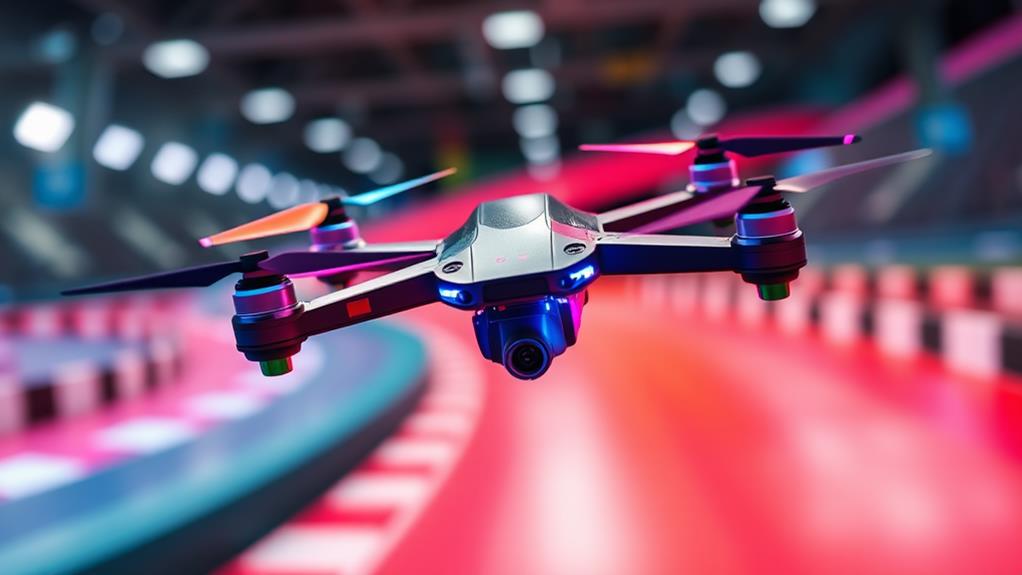
When it comes to racing FPV drones, speed and agility take center stage. Designed for competitive racing environments, these racing drones can reach impressive speeds of up to 100 mph or more. Their lightweight frames are essential; they allow for rapid acceleration, helping pilots fly through tight turns and challenging courses with ease.
Additionally, advancements in battery technology are extending flight times, which is critical for competitive racing scenarios. Racing FPV drones also often feature enhanced camera capabilities for improved live feeds, providing pilots with a clearer view of their racing environment best FPV drones for 2024.
What sets racing FPV drones apart is their specialized components. High-speed motors provide exceptional power, enhancing both speed and maneuverability. This combination of features means pilots can focus on skill and precision rather than worrying about their equipment.
While all racing drones fall under the FPV category, not all FPV drones are built for racing, highlighting the unique engineering behind these models.
The design of racing FPV drones prioritizes performance. Components are engineered for quick response times, allowing pilots to navigate obstacles and execute sharp maneuvers effectively.
In competitive racing, these advantages can notably influence outcomes, making it essential for aspiring pilots to understand the capabilities of their drones. Ultimately, mastering racing FPV drones is about more than just speed; it's about harnessing technology to enhance your flying skills in an exhilarating environment.
Freestyle FPV Drones
Freestyle FPV drones offer a thrilling opportunity for pilots to explore acrobatic maneuvers and creative aerial cinematography. These specialized drones are designed with powerful motors and durable frames, allowing for complex stunts and versatile flying capabilities.
Pilots can perform impressive tricks, such as the Power Loop and Matty Flip, showcasing their skills while capturing stunning footage from unique perspectives. Whether you're a beginner or an experienced pilot, you'll find something to love in the world of freestyle drones.
To enhance your flying experience, consider the following features:
- User-friendliness: Many beginner options, like the EMAX Tinyhawk II and GEPRC Mark4, strike a balance between performance and ease of use.
- High-definition cameras: These drones often come equipped with HD cameras, capturing stunning footage from unique perspectives.
- FPV Goggles compatibility: You'll enjoy an immersive flying experience as you navigate your freestyle drone in real-time.
Pilots navigate through the sky, performing breathtaking tricks and capturing dynamic shots. The versatility of freestyle FPV drones makes them suitable for various applications, from racing to recreational flying.
With the right setup, you can release your creativity and elevate your aerial skills, making every flight an adventure.
Filming FPV Drones
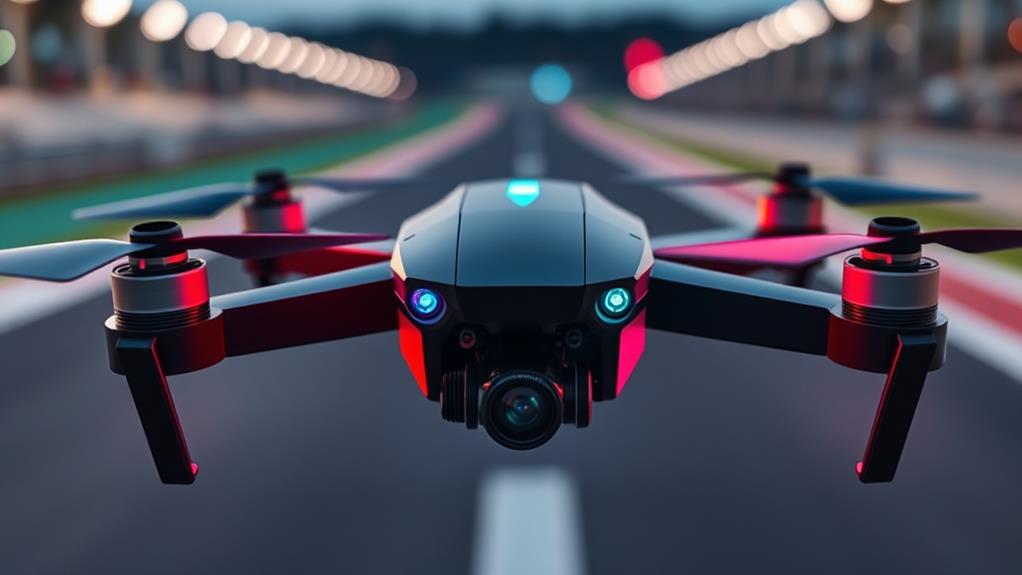
In the domain of aerial cinematography, filming FPV drones stand out for their ability to capture breathtaking footage from unique angles that traditional drones can't achieve. These cinematic FPV drones are designed specifically to deliver high-quality visuals, thanks to their incorporation of high-definition cameras like the GoPro HERO9 Black and DJI FPV Camera.
Advanced techniques and flight patterns showcase how these drones can execute dynamic tracking shots and complex maneuvers for enhanced storytelling.
Equipped with stabilized camera gimbals, these drones guarantee smooth and steady shots, even during dynamic maneuvers. Their agility allows you to navigate tight spaces and execute complex movements, making them ideal for creative storytelling and action sports filming.
Whether you're capturing a thrilling skateboarding trick or showcasing a scenic landscape, filming FPV drones offer unparalleled versatility.
The immersive filming experience they provide elevates your projects, making them suitable for various applications, including real estate videography and cinematic productions.
With the ability to convey emotion and excitement through unique perspectives, these agile drones redefine the way you think about aerial cinematography.
Tiny Whoop Drones
Tiny Whoop drones are perfect for indoor racing, thanks to their compact size and agile design.
Weighing under 250 grams, these drones aren't only lightweight but also safe, often featuring prop guards to protect both the drone and its surroundings.
With the ability to customize builds and a focus on accessibility, Tiny Whoops invite both novice and experienced pilots to enjoy the thrill of indoor racing.
Ideal for Indoor Racing
Often regarded as the go-to choice for indoor racing, Tiny Whoop drones excel in tight spaces and challenging obstacle courses. Their compact design, typically ranging from 1.5 to 3 inches in rotor diameter, makes them perfect for indoor flying. Weighing less than 50 grams, these FPV drones offer incredible agility and maneuverability, key for steering through intricate courses.
Consider the following advantages of Tiny Whoop drones:
- Custom Builds: Pilots can create unique configurations without size restrictions, enhancing creativity in racing competitions.
- Safety Features: Many models have ducted designs, reducing the risk of injury during crashes, which is essential for flying indoors.
- Quick Response: Their lightweight design allows for rapid reactions, vital for avoiding obstacles.
With 1S and 2S LiPo batteries, you can enjoy flight times of 3 to 5 minutes, depending on your flying style.
Tiny Whoop drones not only foster innovation among pilots but also guarantee engaging and thrilling racing experiences. Whether you're a beginner or an experienced racer, these drones offer a fun and challenging way to hone your skills in indoor environments.
Lightweight and Safe Design
The lightweight design of Tiny Whoop drones makes them a favorite among indoor racing enthusiasts. With a rotor diameter ranging from 1.5 to 3 inches and a weight under 50 grams, they excel in compact size, allowing for agile maneuvers in tight spaces.
Safety is a top priority, as these drones often come equipped with prop guards, minimizing the risk of injury or damage during crashes. This feature is particularly beneficial for beginner pilots who are still mastering their flying skills.
Tiny Whoops are typically powered by 1S (3.7V) batteries for indoor racing, but their versatility extends outdoors with the option of 2S (7.4V) batteries. This adaptability makes them suitable for various environments, enhancing the racing experience.
Additionally, the popularity of Tiny Whoop racing has led to a surge in grassroots competitions, where pilots can showcase their creativity through custom builds. These personalized drones allow you to express your individuality while honing your skills.
Long-Range Drones
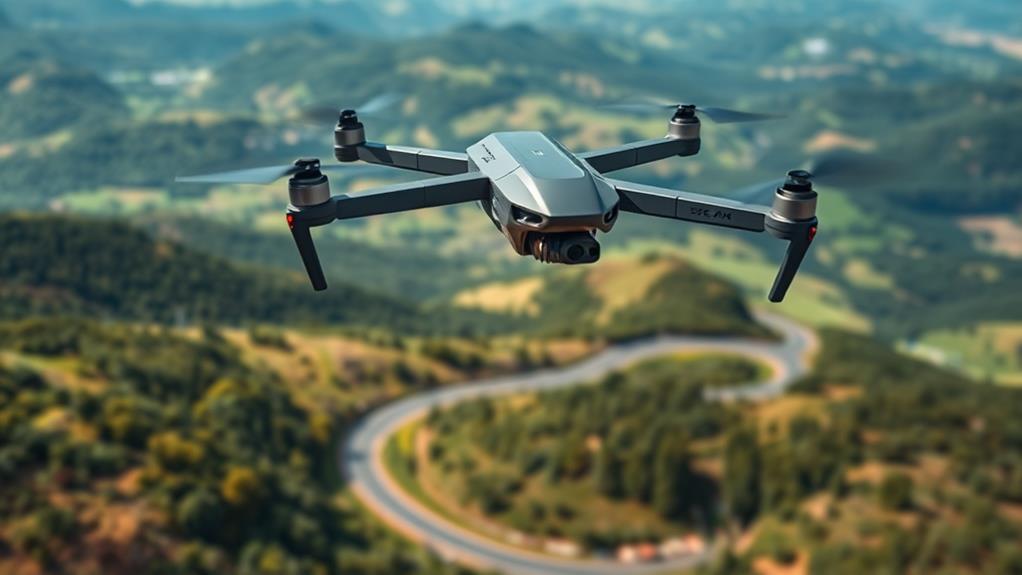
While participating in long-range racing competitions, you'll quickly realize that long-range drones are designed for endurance and speed. These drones typically feature slender designs and high-capacity batteries, allowing them to cover several kilometers without frequent recharging.
As you navigate expansive outdoor courses, optimized aerodynamics and high-efficiency propellers come into play, minimizing drag and enabling higher speeds over greater distances.
Consider these key features of long-range drones:
- Real-time data: Advanced telemetry systems provide essential information on altitude, speed, and battery status, enhancing your control during long-distance races.
- Endurance: Many of these drones achieve flight times of 20 minutes or more, ensuring you can complete the race without interruptions.
- Stable video feed: Maintaining a reliable video feed over long distances is critical for successful navigation, allowing you to fly with confidence.
Equipped with these innovative features, long-range drones are perfect for pilots who want to push their limits in racing competitions.
With their combination of speed, endurance, and advanced technology, you'll find these drones to be a worthy investment for your racing endeavors.
Cinelifters
As you explore the world of drone racing, cinelifters present a unique option for those looking to blend high-quality aerial cinematography with competitive flying. Designed as specialized octocopters, cinelifters can carry heavy camera loads, utilizing 6 to 8-inch propellers for enhanced lifting power and stability.
Their robust frames support the additional weight of high-quality cameras and gimbals, making them ideal for professional aerial cinematography. Equipped with advanced stabilization technology, cinelifters provide smooth and steady footage even in challenging flight conditions. This feature is essential for capturing dynamic shots during drone racing events.
While their primary use is filming, cinelifters can be adapted for racing competitions that permit heavier payloads and larger frames, allowing you to showcase your skills while capturing stunning visuals. In the context of the professional drone racing league, cinelifters can stand out by combining performance with cinematic capability.
Their design often incorporates ducted propellers, enhancing safety and reducing the risk of damage during operation. Whether you're aiming for breathtaking shots or competitive racing, cinelifters offer a versatile solution for drone enthusiasts.
X-Class Drones
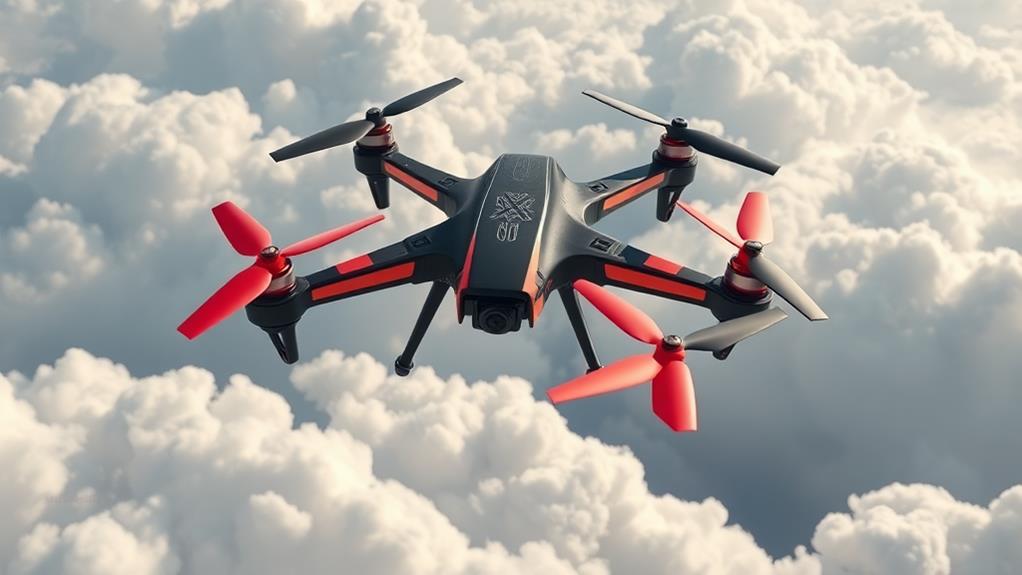
X-Class drones revolutionize the racing scene with their impressive size and performance capabilities. These high-performance racing drones stand out due to their large frames, using propellers ranging from 800 to 1200 mm. This design not only enhances speed but also allows for heavy payload capabilities.
However, operating X-Class drones isn't for everyone; advanced piloting skills and technical knowledge are essential for peak performance.
Here's what makes X-Class drones unique:
- Custom-built configurations: You can tailor these drones to fit your individual racing preferences and conditions.
- Impressive speeds: When you master them, X-Class drones can reach remarkable velocities, making them a thrilling choice for competitive racing.
- Emerging globally: As X-Class racing grows, it presents new opportunities for enthusiasts to participate in a sport that's still finding its footing.
While these drones aren't recommended for beginners, their complexity and potential for speed contribute to their allure in the competitive racing world.
As interest in X-Class racing expands, you may find yourself drawn into this exciting and evolving arena, where innovation and skill combine for exhilarating experiences.
Conclusion
In the thrilling world of drone racing, each type serves a unique purpose, catering to different skills and preferences. You might think that investing in a specific type limits your options, but that's not the case. Each drone opens doors to new experiences, whether you're competing, filming, or exploring. By understanding these seven drone types, you'll find the perfect fit for your racing journey. So, gear up, choose your drone, and take to the skies with confidence!
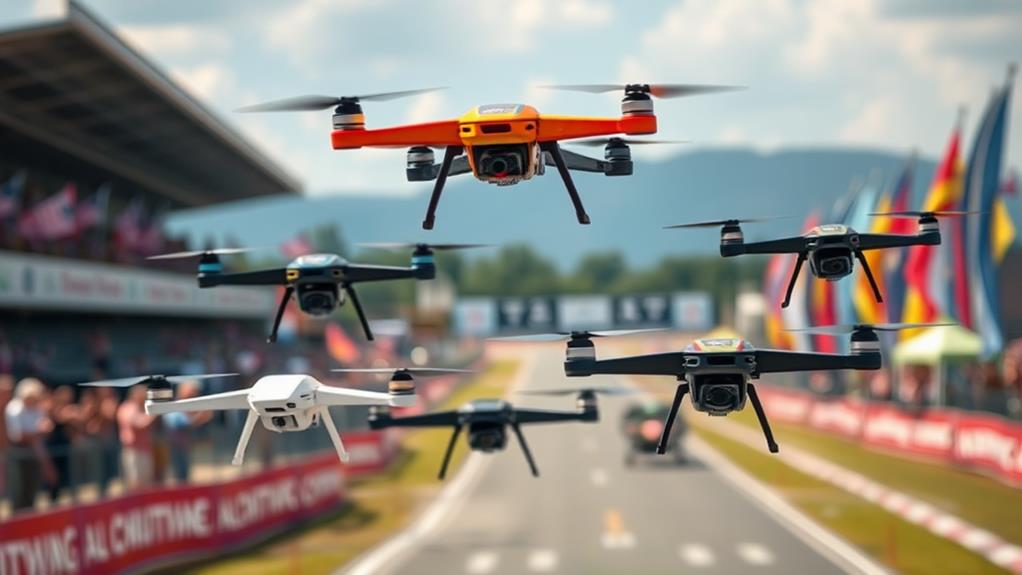
Leave a Reply